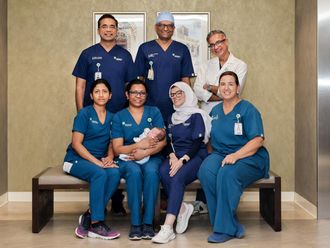
Abu Dhabi: Parents in the capital have praised new measures to make children’s toys safer, but called for more awareness about safety certifications.
Last week, the Abu Dhabi Quality and Conformity Council (ADQCC) launched a voluntary scheme to mark toys that meet UAE safety standards with the Abu Dhabi Trustmark. Across the UAE, a strict set of regulations enforced at the beginning of the year by the Emirates Standardisation and Metrology Authority (Esma) requires toy manufacturers and importers to get their products certified by authorised entities, after which they are granted the GSO Safety Mark.
While most residents agree that regulatory authorities should test toys that are put on sale, they pointed out that it is parents’ responsibility to ensure children’s safety.
Sara Mujalled, 32, a banking executive from Jordan, said: “Before we buy something for our children, we always read the labels. We pay special attention to the age restrictions on toys. We also look out for small parts and sharp edges.”
The mother-of-two, whose children are aged two and five, buys toys from reputed retailers and avoids those from smaller stores with dubious packaging.
“I did not know about the safety marks. Since such rigorous tests are run by two different authorities, parents should be made aware of what these safety marks mean. They would feel more assured about their purchases,” Mujalled said.
Danielle Roy, 45, a Canadian homemaker, was also unaware of the GSO Safety Mark and the Abu Dhabi Trustmark. She pays less attention to toys she buys now that her three children are older (the youngest is four) and are less likely to chew or swallow toys and small parts.
“We used to be careful about age restrictions and small parts when they were younger,” she said.
“It is good that toys in the UAE are tested, but it is still a parent’s responsibility to check that the toys they buy are safe, especially as cheaper items are available at stores,” Roy added.
Not all parents are careful. A South Asian parent, who declined to be named, said that he often bought toys off the street.
“Unfortunately, I can’t afford to buy certified toys. Before I buy a toy on the street I inspect its parts to make sure it is safe,” the parent who works as a receptionist said.
Abdullah Al Maeeni, director of conformity affairs at Esma, said that toys sold in the UAE are put through rigorous tests. The standards are higher than in many European countries.
“In most countries, toy manufacturers include safety assurance marks on their own, known as self-declaration, or from certifiers they select. This was also the practice in the UAE and other Gulf Cooperation Council countries till last year. Now, safety marks are only granted by authorised third parties. This ensures greater confidence because toy manufacturers cannot make untested claims about safety,” he explained.
The standards differ based on which age group the toy is intended for. “So something for a five-year-old child could include smaller parts, but this would not be acceptable in toys for smaller children,” Al Maeeni said.
He urged parents to look for the GSO Mark when they purchase toys.












